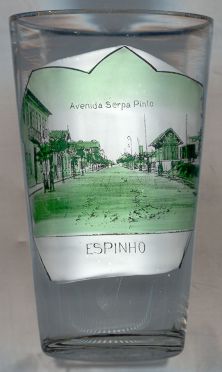

|
| PORTUGAL | |
| distrito de Aveiro |
 Espinho is situated on the Portuguese Atlantic coast about 20 km south of Porto and
50 km north of Aveiro. Until the first decades of the 19th century Espinho
was a small fishing village. From the 1830's onward, it developed into a popular sea-side spa,
especially after the town was connected to the Portuguese northern railroad in 1867.
Espinho became a parish in 1889, a civil (administrative) parish in 1891, and a township in 1899.
Espinho is situated on the Portuguese Atlantic coast about 20 km south of Porto and
50 km north of Aveiro. Until the first decades of the 19th century Espinho
was a small fishing village. From the 1830's onward, it developed into a popular sea-side spa,
especially after the town was connected to the Portuguese northern railroad in 1867.
Espinho became a parish in 1889, a civil (administrative) parish in 1891, and a township in 1899.
The picture on the glass shows the  Avenida Serpa Pinto which
crosses the town from north to south parallel to the coast between the coast and the railroad.
Today, Espinho is a unique case in Portugal, and indeed also in Europe, that it has abandoned
naming its streets and has replaced street names by numbers. The present-day name of
Avenida Serpa Pinto is Avenida 8.
Avenida Serpa Pinto which
crosses the town from north to south parallel to the coast between the coast and the railroad.
Today, Espinho is a unique case in Portugal, and indeed also in Europe, that it has abandoned
naming its streets and has replaced street names by numbers. The present-day name of
Avenida Serpa Pinto is Avenida 8.
Alexandre Alberto da Rocha Serpa Pinto was a well-known Portuguese explorer. He was born in 1846 in Tendais (today part of Cinfães) in the Viseu district. Serpa Pinto crossed the African continent in an eastward direction and explored the headwaters of the Zambezi river to the Victoria Falls in present-day Zimbabwe. His book "How I crossed Africa" was published in 1881. Nominated Governor of Moçambique in 1889, he tried to enlarge the Portuguese possessions in Africa but failed in Matabeleland and was called back in 1890. He died in Lisbon in 1900.
|
With very special thanks to José M. Leal da Silva from Lavradio, Portugal, for donating this glass and for repeated valuable help in finding informations about the places depicted on the glasses of this collection. |
![[scale]](lineal.jpg)